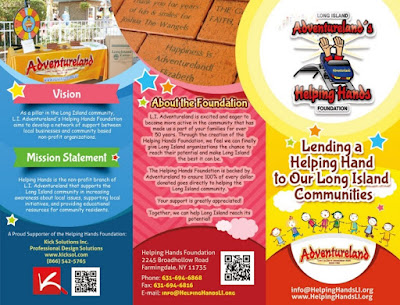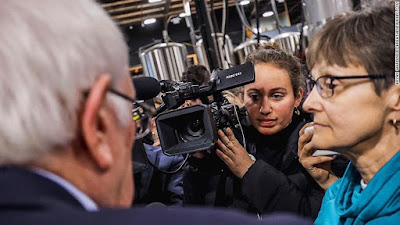Brochures—Controlled Media on Services, Events
 |
| Sample of tri-fold brochure. Outside panels arranged as 3 layout units. |
Read for Sept. 9, 2024: There is a difference between controlled and uncontrolled PR media. News releases, although they are usually posted on an organization’s web site, are considered “uncontrolled” because their main purpose is to generate coverage via news media.
You send a news release to "The Des Moines Register" in the hopes that the Register then published favorable information about you. But the Register controls if and how and in what form its audience sees your information—the format and context of the story is not something you control.
A brochure is controlled media, and generally a concise publication that describes something that’s important for your organization to promote. For example, Mount Mercy University has what its admissions department calls “one sheets,” which are one-page printed descriptions of each academic program. These are a form of brochure.
A brochure thus:
- Is a descriptive PR document.
- Generally, is not “periodical” like a newsletter or magazine. It does not have a "new edition" on a regular basis. However, it should be kept up-to-date--a well done brochure may last two or three years, but beyond that is getting past-due for an update because the world changes.
- Includes a mix of writing and graphic design that makes it, if done properly, a larger project than one might assume.
- Is often distributed via “pickup,” that is, in a lobby or at a site or convention, someone may pick one up; or via mail along with other materials. If someone inquires about your services, for instance, a responding employee will often write back and enclose a brochure. Brochures are also web pages or pdf files on the web, and thus they may be emailed or ordered via a web form.
I will discuss, later in this post, a different kind of brochure. But for now, the main kind I want you to focus on is the publication that describes an important aspect of your organization. In the commercial world, any aspect of your organization that external publics inquire about are candidates for the production of such a brochure. Thus, any discrete service or product that your company or organization offers to external publics is likely to have its own brochure. And in a large organization, where their may be thousands of people in an internal public, internal services may need brochures as communication tools.
As controlled media, writing rules for brochures are not as strict as uncontrolled media. You don’t have to write in the inverted pyramid as you would for a news release, for instance. You can include promotional language in a product brochure that would seem out of place in a release. But there are some keys to brochure copy writing, including:
- Write concisely. A brochure is often a physically small publication, and being wordy is not a good idea. They are also carefully designed, so copy has to fit into a graphic design format—which means you are writing less words than for many other PR media.
- Write informatively. While you can be promotional in brochure copy, it’s easy for publics to dismiss your brochure if they don’t find the words helpful or believable. Explain, accurately, the features and information that publics want to know.
- Take care with time elements. This was more critical in the past when brochures were always commercially printed. They still often are, but color printers allow for more "on demand" production, and of course, a web version can always be updated. But, it’s still important to take care with time elements. You don’t want to refer to Nov. 1, 2024, as being in the future in a brochure about the Academic Center for Excellence, because that brochure copy then “ages out” on Nov. 1. Recall that brochures are not newsletters—they are not periodicals. You must write copy so that it’s more timeless than in more ephemeral PR media.
Brochures are usually printed on standard size paper, although often on more expensive or slicker paper than plain paper stock. There are many formats that a brochure can be printed in—the MMU “one sheets” are simply one sheet of paper, with no fold. More common is a format I’ve sure you’ve seen many times—the “tri-fold.”
The tri-fold is created by folding a standard piece of 8 ½ by 11-inch paper with two folds, creating six panels. The outer third is a “cover” panel. There is also a visible back panel, which sometimes is left blank for mailing, and the other third of the exterior, folded inside and visible when the reader unfolds the cover. These three exterior panels are most often designed as three distinct units or pages.
The three panels on the inside can be designed as individual units, too—meaning a simple tri-fold has, in effect, six very small pages. However, since all three interior panels are visible once a reader unfolds the brochure, its also common for these three panels to be treated as one horizontal page where the largest block of copy would go.
As your text notes, there are a variety of other formats. A “legal” size paper, which is deeper than a standard size page, can have three folds and create a brochure with four exterior panels. A paper can also be folded once and create more of a booklet look. The tri-fold is more popular than any of these for several reasons. Many brochures will end up on display racks that are built for that standard size. Also, brochures are often mailed, and the tri-fold is sized to fit comfortably in a standard business envelope.
 |
| Sample cover of a Collins Aerospace brochure--not a tri-fold brochure. |
Anyway, the style text is correct and complete in its description of the writing approach needed for a brochure. Note that it identifies that shelf life as a key issue.
Page layout software, such as InDesign or even Word, often comes with template layouts for brochures. There are also many templates that vendors provide online. For a quick-and-dirty job that is an internal document for a small public, this template approach may be adequate, but most organizations would never—never—use a template design for any external PR communication.
The last thing you would want is for your brochure to look cheap and amateurish, and using a pre-designed template is pretty much, in the media world, the definition of “cheap and amateurish.” Of course, an organization often does have its own "standard look" for a family of brochures--MMU's one-page program summaries are an example--but this is different than using an external template.
Using a vendor template would be akin to your using the most bland and boring of templates on your professional personal blog, which is something I would expect none of you would do. Instead, you take the time to make your blog stand out and seem professional through some design flair. Hint, hint.
Anyway, property done, a brochure is a fairly complicated project that involves multiple people. Typically, there will a copy writer (you), a designer, possibly a photographer and always an editor involved. It takes some time to plan and execute—it’s not a one-person job that takes only a few hours.
So, a brochure, like a well-done newsletter, is a team project. The writer is a key component of that team, but their work has to be coordinated with, and match, the design.
A brochure can, and often does, use more of a “label” approach to headings. While expressing a complete thought on copy—thus a headline—is allowed, the concise format means that headings, especially on the cover, are often truncated to the point where they are no longer a sentence and thus not headlines. That’s OK, as long as the heading copy still makes sense and the heading still appeals to and communicates with the intended public.
Beyond the standard brochure—which is what your text is mostly describing and that I’ve been writing about so far, there are other permutations of the brochure idea. While the standard brochure is a timeless and important tool both for PR and marketing, the brochure idea may be more tied to a specific thing or event.
 |
| Example of an event brochure--showing a map to beers. Wish I was there. |
An event program, for instance, can be thought of as a specialized brochure—often done in booklet, rather than tri-fold, format.
In production terms, brochures are usually printed on a press. The MMU one-sheets are computer files that are printed on an as-needed basis. With the quality of color printers today, that’s an option for some of the specialized event brochures.
However, most marketing brochures will be prepared by a printer with a press and not printed via laser printer. The quality of reproduction and paper is still better from commercial printers, and in the marketing world, quality is key.
Brochures transcend the PR world and are often used for marketing. Marketing is concerned with selling services or goods. Thus, many corporate brochures are correctly considered marketing tools, not PR tools. As you should know, public relations is a discipline that is concerned with delivering key messages to external and internal publics—it’s purpose is broader than marketing, but related to it, too.
Marketing and PR are not exclusive and should support each other. At smaller organizations, like Mount Mercy, it’s common for a single office to handle both functions—hence the “marcom” informal name for the office at MMU that handles PR—short for “marketing and communications.” At a larger organization, PR and marketing are more likely to be two different departments, but ones that frequently work together.
Your text claims that communication professionals “will write and/or monitor the production of brochures more than any other public communication product.”
I’m not sure where the data to back that up would come from, and I’m suspicious of it. In my experience, there are many more news releases in the communication universe than brochures.
But, if you use a broad definition of “brochure” to include things like posted notices, I concede that many brochures are created. And even if I think the text oversells the brochure, I would concur that any PR writer needs to be familiar with brochures, understand them and know how to create copy for them as needed.

Comments
Post a Comment